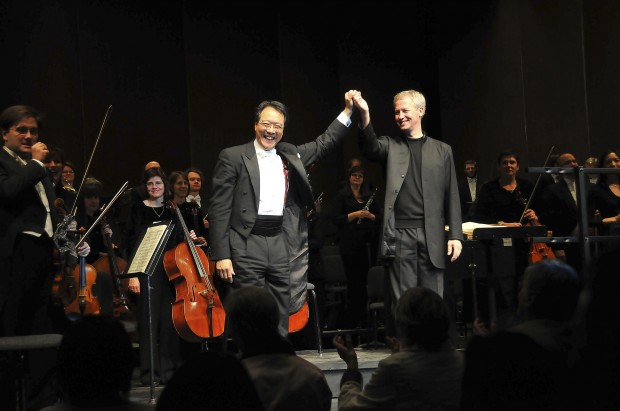It was the hottest classical music ticket of the year - Yo-Yo Ma, one night only, with the Tucson Symphony Orchestra, playing Dvorák's Cello Concerto in B minor.
It's hardly news that it sold out long before Saturday's concert. Nearly 2,300 people packed every seat at the Tucson Music Hall. And when the seats were full, the TSO opened up the orchestra pit area in front of the stage and pulled in more seats, and set even more seats on a platform in the balcony.
The concert had "once in a lifetime" written all over it, and with good reason: This was Ma's first appearance with the TSO, and it was years in the making. And chances are it will be years before he returns.
Ma came to Tucson to play a piece that he knows intuitively; he played it last Wednesday with the Colorado Symphony. Yet he manages to play the Dvorák with a freshness that leaves every audience feeling as if it were the first to hear this.
It's part of Ma's charm as a performer - the ability to go beyond the music and discover the humanity. You see it in his musical prowess, the ability to convey every emotion so deeply that you're convinced he's channeling the composer as he sat penning the piece more than a century ago.
But you feel it most profoundly in the way he interacts with the orchestra: a gracious nod, an ear-to-ear grin, a smile so warm and genuine you want to hug him.
Throughout Saturday's 40-minute performance, Ma was smiling. He turned in his seat and shot a warm smile to the viola section, then turned in the opposite direction and came face-to-face with concertmaster Aaron Boyd, who got Ma's full-toothed grin that spoke volumes. We in the audience couldn't help interpret it as Ma telling Boyd, "This is fun."
His commanding, friendly stage presence, of course, is only part of Ma's appeal. When he pulled the bow over his cello and produced a luxuriant tone that resonated throughout the hall, the true essence of the music man came through.
He is called the greatest living classical musician for a reason, and we discovered it firsthand Saturday. He is a cellist whose energetic, inspired technical skills mesmerize from the first stroke.
He is equally masterful as an interpreter, bringing out every nuance of Dvorák's concerto: the boundless joy, the palpable anxiety and the deep melancholy.
Dvorák wrote the concerto during his stretch in America in late 1894 to early 1895. He composed it for Bohemian cellist Hans Wihan, who was Dvorák's editor for the work. But apparently Wihan wanted to tweak it too much for Dvorák's tastes, including adding a cadenza to the stormy finale. Some musicologists have speculated that Wihan viewed the cello's role as too difficult, and he wanted to simplify it. Dvorák ignored all but a few of the suggestions.
Ma, who recorded the concerto with the New York Philharmonic in 1995, played the solo passages with so much energy and passion that he shredded his bow three times.
But as much as Ma was the star of the evening, the orchestra and conductor George Hanson were close runners-up. They turned in a world-class performance that went beyond rising to the occasion of having a superstar in their midst.
Saturday's audience gave Ma a prolonged standing ovation, which he shared with the orchestra, singling out for attention Boyd, the viola section and the winds. Ma shook hands with several musicians and planted a kiss on the cheek of principal cellist Xiao-Dan Zheng. He also thanked from the stage the concert's sponsor, Norma Zimdahl.
"This was an extraordinary experience for me," he told the audience before playing as an encore a snippet of Bach's Cello Suite No. 6.
Beethoven's Fifth Symphony splendidly occupied the concert's first half, although the orchestra seemed a bit off-kilter in the first movement. There were times when it sounded like the orchestra was not on the same page; cues were off and the music didn't seem on track. At the end of the movement, half of the houselights came on, and Hanson stood silent for several moments before going into the second movement. From then on, whatever had been wrong was corrected, because the orchestra sounded superb.





